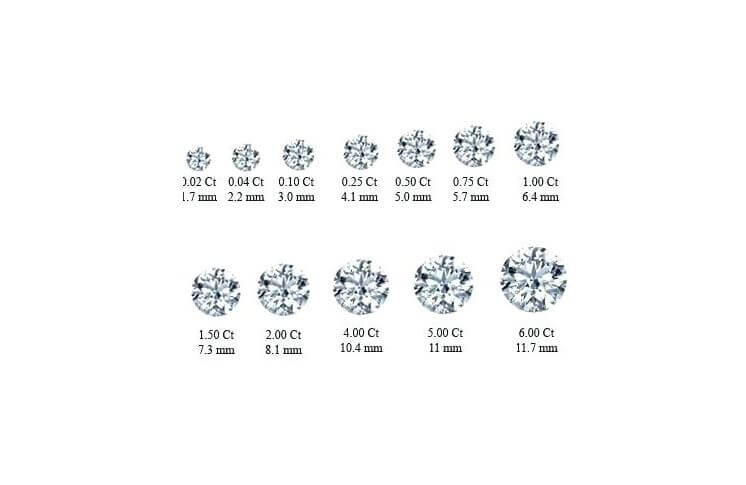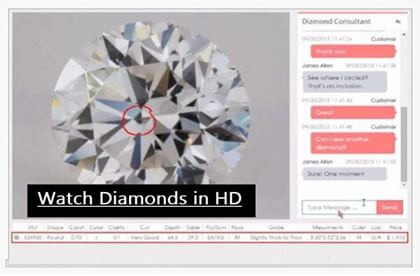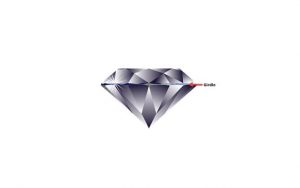Executive Summary
The carat weight of a diamond refers to the weight of the diamond and not the size of the diamond-like people have wrongly presumed. In many cases, it determines or is closely related to the size of the diamond but it is not the unit for measuring diamond size. Diamond size is measured in millimeters (mm) while diamond weight is measured in carat weight (ct.).
To prove that carat weight does not refer to or measure diamond size, there are different diamond shapes with the same carat weight but the diamond sizes vary considerably. This is due to the difference in the density of the different diamonds. The shape of a marquise diamond, for instance, makes it appear bigger than round diamonds. So if you have a round diamond of 1 ct. and a marquise diamond of the same weight, the marquise diamond will appear bigger than the round diamond.
Diamond carat weight can be manipulated to fit your budget. It is usually the last of the 4Cs that you consider when buying a diamond. Larger diamonds with higher carat weight are usually rarer in nature than smaller diamonds with lower carat weight. The bigger diamonds are usually more expensive than the smaller ones because of their rarity.
As the carat weight of the diamond increases, the price increases exponentially. The general thumb rule is that, as the diamond weight doubles, the value increases by four times. This exponential increase in price however, does not mean that the actual size of the diamond also increases exponentially. The size increase is usually not that much.
The carat weight of a diamond is the least important of a diamond’s characteristics unless you personally have a thing for diamond weight and sizes, the most important diamond characteristics are the cut, color and clarity (in that order) before carat weight.
Carat (ct.) is a unique unit used exclusively to measure the weight of diamonds and gemstones. The word “carat” was gotten from “carob” seed, which was the first unit that diamond traders used to measure diamond weights. One carat weight is equal to 0.2g.
The carat weight of a diamond is probably the most misunderstood of all the 4Cs of diamonds but it is very important in the evaluation of a diamond price. Many have thought the carat weight refers to the size of the diamond but in truth, it refers to the weight of the diamond. Although the carat weight of a diamond, in some way, affects the diamond size, it is not the unit for measuring a diamond size. The diamond size is measured in millimeters (mm). The size of different diamond types with the same carat weight may differ because of the difference in the density of the diamonds. This just proves that the carat weight isn’t the measure for a diamond size.
Impact of Carat Weight on Diamond Price
After sorting out your preferred diamond cut grade, color grade, and clarity grade in that order of importance, the next big thing is the carat weight of the diamond. The good thing about diamond carat weight, like another member of the 4Cs, is that it can be manipulated to fit your budget. Generally, large diamonds are more expensive than smaller diamonds because they are rarer and less commonly found in nature than the smaller ones. As a matter of fact, the price of a diamond increases exponentially (and not linearly) with an increase in carat weight. For example, you will expect that a diamond of 2 carat weight will cost the same price with 2 diamonds of 1 carat weight each when their prices are added together. But that is not the case. Two carat weight diamond is way more expensive than buying two 1ct. diamonds. The general thumb rule is that, as the diamond weight doubles, the price increases by four times. But then, the carat weight is not the only thing that determines the price of a diamond, other factors of the 4Cs also come into play. So it is not impossible that you will see two diamonds with the same carat weight and they have a significant difference in price.
Approximate Carat Weight and Size Chart
When comparing the carat weight of different diamonds to their respective sizes. It is important to put their respective cuts into consideration as well. A diamonds may have a high carat weight but if it also has a poor cut grade, the diamond will have a deeper cut and appear smaller than it should be. So a diamond with a smaller carat weight but a better cut may appear bigger than it does.
Diamond price may increase exponentially with an increase in carat weight but the actual size of the diamond does not increase that much. As the diamond weight increases, the total price of the diamond not only increases but the price-per-carat as well.
The table below shows the relationship between diamonds of different carat weights. The perceived size of the 1.00 ct. diamond and the 3.00 ct. a diamond may triple, but the diameter only increases by 45% (6.50 – 9.40 mm) and the crown area is only a little higher than double (33.2 – 69.4 mm2).
|
carat weight (ct.) |
diameter (mm) |
crown (mm2) |
total price ($) |
|
1.00 |
6.50 |
33.2 |
6000 |
|
2.00 |
8.20
|
52.8
|
24000 |
|
3.00 |
9.40 |
69.4 |
54000 |
The shape of different diamonds is another reason why two diamonds with the same carat weight will appear to have different sizes. For example, the marquise diamond mostly appears bigger than round diamonds. so if I compare a 1 ct. marquise diamond side by side with a 1 ct. round diamond, the marquise diamond will appear slightly bigger. The difference in the way both diamonds are cut plays an important role here.
| carat weight | approximate diameter size |
| 0.25 ct. | 4.00 mm |
| 0.50 ct. | 5.10 mm |
| 0.75 ct. | 5.80 mm |
| 1.00 ct. | 6.40 mm |
| 1.25 ct. | 6.90 mm |
| 1.50 ct. | 7.30 mm |
| 1.75 ct. | 7.70 mm |
| 2.00 ct. | 8.10 mm |
| 2.25 ct. | 8.50 mm |
| 2.50 ct. | 8.90 mm |
| 2.75 ct. | 9.00 mm |
| 3.00 ct. | 9.30 mm |
| 3.25 ct. | 9.50 mm |
| 3.50 ct. | 9.75 mm |
| 3.75 ct. | 9.90 mm |
| 4.00 ct. | 10.10 mm |
| 4.25 ct. | 10.43 mm |
| 4.50 ct. | 10.63 mm |
| 4.75 ct. | 10.83 mm |
| 5.00 ct. | 11.01 mm |
Buying Tips
- Consider the diamond cut and other members of the 4Cs before the carat weight. The diamond cut being the most important, as it also affects the carat weight of the diamond.
- Buy shy of the mark. With a slight increase in carat weight, there’s an exponential increase in price. You can use this to your advantage by slightly reducing the carat weight from the common whole or half mark. For example, instead of buying a diamond of 2.0 ct., you can decide to buy a diamond of 1.9 ct. or 1.8 ct., the difference in weight will not be noticed but the difference in price is significant and you can save that much.
- If you want a large diamond (which is usually expensive) but you are working with a tight budget, you can make up for the price with the other 4Cs. You can settle for a diamond with a good cut grade, a clarity grade of S1 – S2, an I or J color grade. This should only be if your priority is the diamond size and carat weight. Don’t forget to look out for very visible colors and inclusions though.
- Some diamond settings don’t go with some diamond shapes and sizes. So, if you’ve already ordered a particular diamond size, be sure that your setting is right for it. And if you have a preferred setting, make sure that the diamond spec fits in with your preferred setting.
Bottom Line
The carat weight is only important for knowing the weight of the diamond but it isn’t the most important thing to look out for in a diamond, the cut is. If the cut is excellent or very good, the diamond size will ideally increase with the carat weight. The most important thing is to choose the largest carat weight that fits into your budget after you have considered cut, color and clarity first.




